In the digital world, your website’s visibility depends on more than just great content — it also relies on how many other sites vouch for you. These votes of trust come in the form of backlinks, also known as inbound or incoming links. A backlink is simply a hyperlink from one website to another, but its impact on search engine rankings can be massive.
Think of backlinks as recommendations. If a trusted website in your niche links to your content, search engines like Google see it as a signal that your page is valuable, credible, and worth showing to more people. The more high-quality backlinks you earn, the higher your chances of ranking well in search results.
Backlinks also bring targeted referral traffic, build brand authority, and help establish your expertise in your field. However, not all backlinks are equal — quality, relevance, and natural placement matter far more than quantity.
In this article, we’ll explore what backlinks are, why they’re important, the different types, and proven strategies to build them effectively for long-term SEO success.
What Are Backlinks?
Backlinks — often called inbound or incoming links — are simply links from one website that lead to another. They act like online recommendations, directing both people and search engines toward your content. When a reputable site links to yours, it can bring visitors directly to your pages and also boost your chances of appearing higher in search results.

From your website’s perspective, these are backlinks. From the linking site’s perspective, they’re external or outbound links. It’s the same link — just seen from two different angles.
Backlinks can happen naturally when others find your content useful and decide to reference it. Or, you can actively work to earn them through strategies like guest posting, digital PR, or partnerships.
If you want to see who’s linking to your site, Google Search Console offers a “Links” report. In the “External links” section, you can find details such as your most linked pages and the websites sending you the most traffic. You can even download this data for deeper analysis.
The page giving the link is often referred to as the source or referring page, while the page receiving the link is the target.
Before diving deeper, let’s look at why backlinks are such a powerful force in SEO.
Why Are Backlinks Important in SEO?

Backlinks play a crucial role in SEO because they help search engines determine whether your content is trustworthy and valuable. In simple terms, when other websites link to your pages, it acts as a public endorsement. Google takes both the number and quality of these links into account to assess how authoritative your site or individual pages are — and that authority directly influences where you appear in search results.
Take the keyword “iPhone reviews” as an example. The pages ranking at the very top of Google for this term often have thousands of backlinks pointing to them. And the domains hosting these pages can have millions of backlinks in total. This strong backlink profile signals to Google that the content is reliable and worth recommending to searchers.
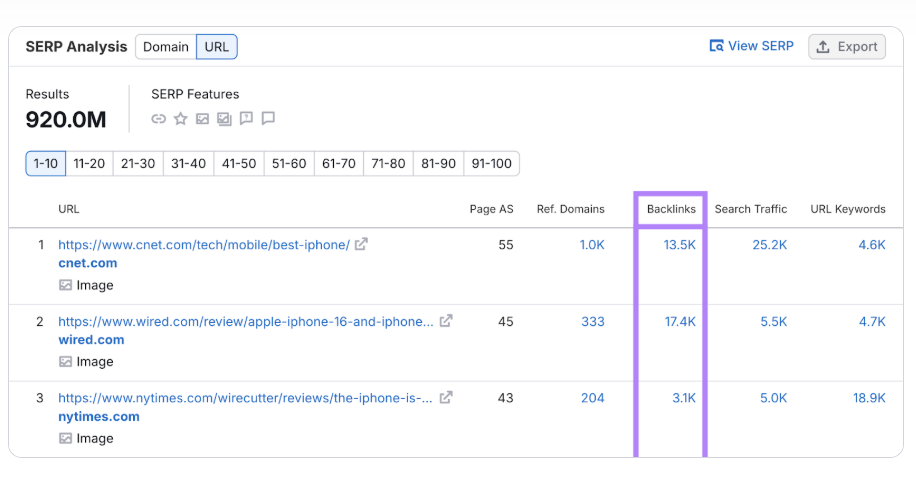
This process ties back to Google’s famous PageRank algorithm. PageRank measures the authority of a page and allows it to pass some of that authority — often called link equity — to other pages it links to. The higher a page’s authority, the more equity it can transfer. Importantly, linking to other sites doesn’t reduce the authority of the linking page; it simply shares credibility with the destination page. Help of google Analytics
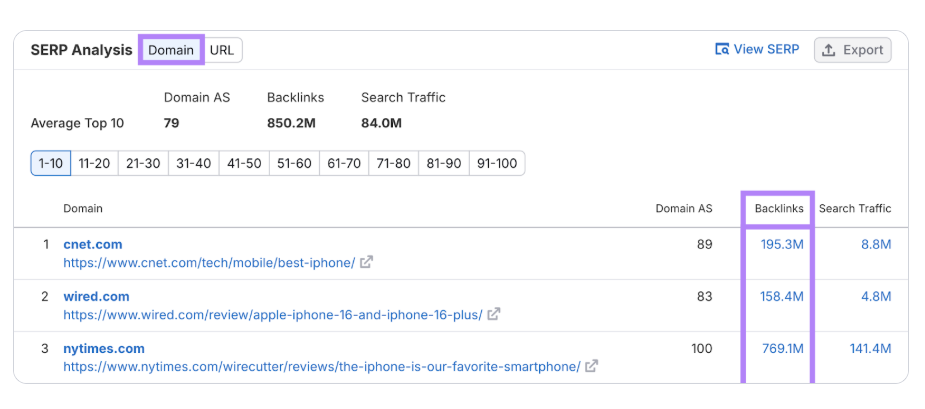
While backlinks aren’t the only factor that determines search rankings, they are among the most influential. In fact, research shows that many of the top 20 ranking factors are link-related — including domain authority, page authority, the number of unique referring domains, and the total volume of backlinks at both the domain and page levels.
However, not all link-building practices are welcomed by Google. The search engine has clear link spam policies designed to prevent manipulative tactics. If you engage in shady link-building methods, you risk facing penalties that can significantly damage your SEO.
In the next section, we’ll explore ethical, effective ways to earn high-quality backlinks that strengthen your authority and boost your search performance.
What Affects the Value of a Backlink in SEO?
Some backlinks are more beneficial for SEO than others, some have the potential to harm your rankings, and some probably have no impact.
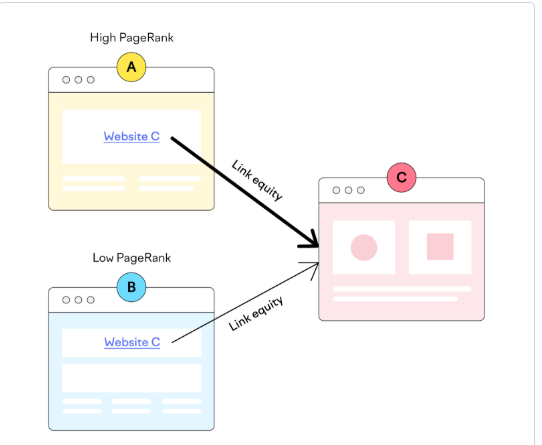
Let’s explore the main factors that affect the value of a backlink in SEO:
Follow Status
When Google transfers link authority through a hyperlink, it’s referred to as “following” the link.

Website owners can signal to Google that they prefer the link not to pass ranking credit by adding specific attributes to the link’s HTML code:
- rel=”nofollow”: Indicates that the linking site does not endorse or vouch for the target page
- rel=”sponsored”: Denotes that the link is part of a paid advertisement or sponsorship
- rel=”ugc”: Marks the link as user-generated content, such as in comments, forums, or reviews
Conversely, follow links (sometimes called do-follow links) lack these attributes. These links generally allow Google to pass link equity, though it’s important to note that Google doesn’t always guarantee a positive SEO impact from every follow link.
For example, backlinks placed in blog comment sections may be ignored by Google even if they aren’t tagged with no-follow attributes.
It’s crucial to regularly verify the follow status of your backlinks—both existing and new—to ensure you’re not missing out on valuable link equity or inadvertently violating Google’s best practices.
While you can manually inspect link attributes in the HTML, using a dedicated Backlink Audit tool streamlines this process and makes it more efficient.
If you encounter a backlink with an incorrect or undesired follow status, consider reaching out politely to the site owner or webmaster to request a correction.
Domain and Page Authority
The more reputable and influential the referring domain and page, the greater the impact a backlink can have on your SEO.
For example, a backlink from a highly respected organization like the World Health Organization will generally carry significantly more authority than a link from a small, lesser-known health blog.
It’s common to accumulate backlinks from websites of varying levels of credibility, but prioritizing links from high-authority sources can make your link-building efforts much more effective.
Although Google doesn’t offer an official metric for measuring site authority, tools like Semrush provide an Authority Score (AS) that serves as a useful estimate.
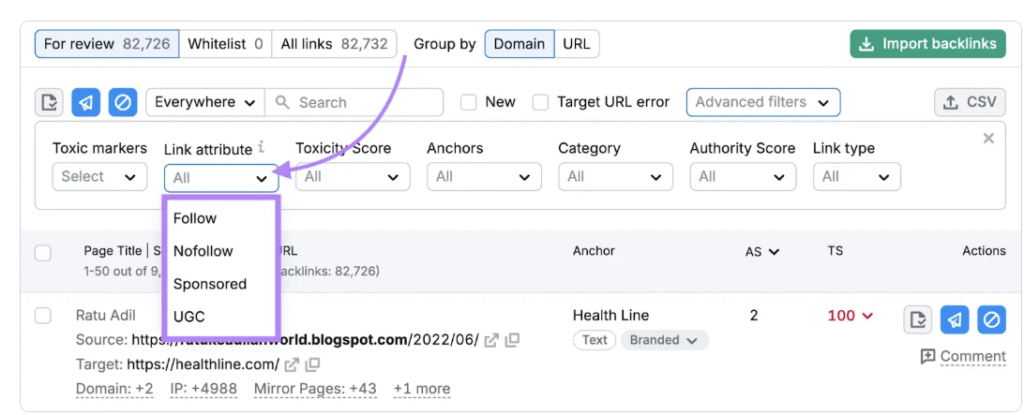
Link strength: The overall quality and volume of backlinks
Organic traffic: The estimated number of monthly unpaid visits coming from search engines
Natural link profile: How organic and trustworthy the backlink profile appears, as opposed to spammy or manipulative
This means you can leverage the Authority Score to assess the value of your current backlinks as well as potential new ones, helping you monitor your progress in growing your site’s SEO authority.
Topical Relevance
Topical relevance refers to how closely connected the linking page or website is to the page or site it’s linking to.
Backlinks from highly relevant sources tend to be more valuable because they appear more organic and are often given by experts in the same field, making their recommendations more credible.
For instance, Healthline receives backlinks from well-established healthcare organizations like the Centers for Disease Control and Prevention (cdc.gov):
These links are likely to carry greater weight than backlinks from equally authoritative sites outside the healthcare niche, such as sports-related websites.
The Likelihood of the Link Being Clicked
Links that are more likely to be clicked may carry greater SEO value because this indicates to Google that the link holds more significance for users.
Google’s reasonable surfer model—outlined in one of its patents—examines the probability of a link being clicked by considering factors such as:
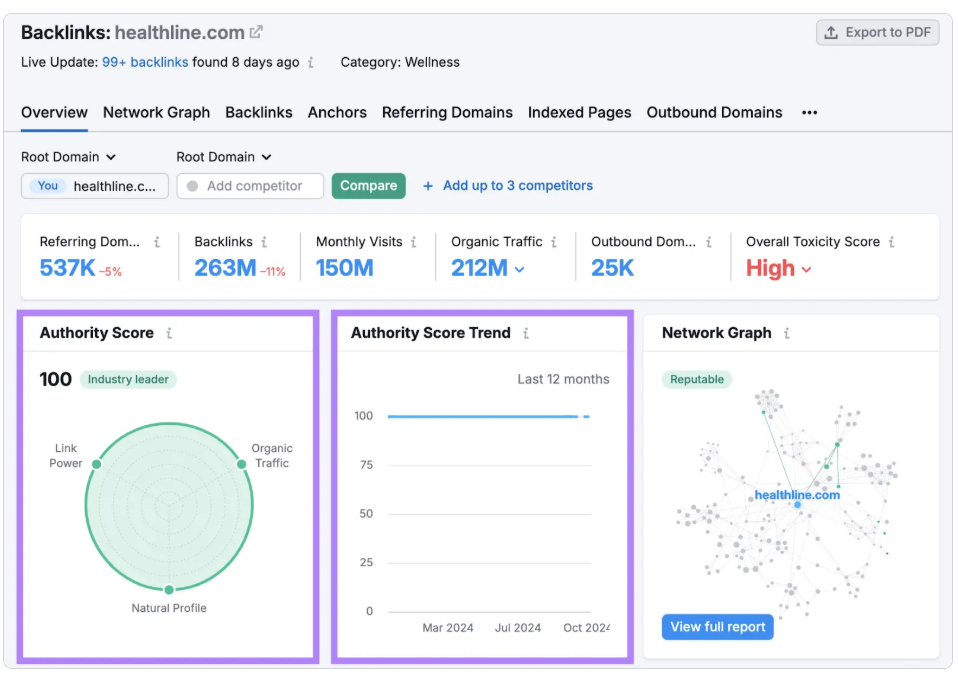
- Link placement: Backlinks embedded prominently within the main content are more likely to attract clicks than those tucked away in the footer or sidebar.
- Content quality: Links within well-written, authoritative content tend to receive more user engagement.
- Link density: Pages with fewer total links increase the chances that each individual link will be clicked.
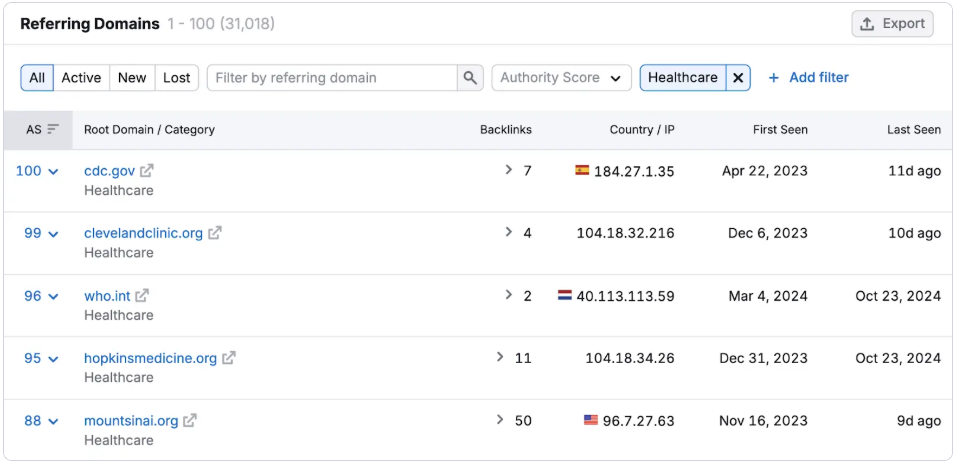
Google may incorporate this model when evaluating the value of links.
For example, having your product featured as the top suggestion in a curated gift guide is likely to be more beneficial than being buried as the last item in a list of 100 recommendations.
Anchor Text
Anchor text is the visible, clickable text in a hyperlink, and it can influence the value of a backlink.
For example, a link might have anchor text like “this article from Healthline,” which points to another page.
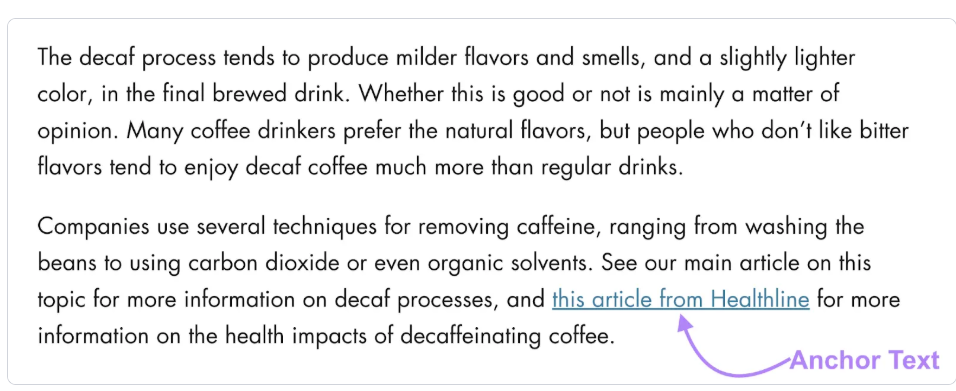
Search engines analyze anchor text to better understand the topic of the linked page. Because of this, some marketers try to manipulate rankings by creating many backlinks with keyword-rich anchor text.
For instance, they might use awkward or repetitive phrases such as “buy men’s wedding shoes and wedding shoes for men online,” or build numerous backlinks with the exact anchor text “men’s wedding shoes.”
However, this tactic is considered a form of link spam and can result in penalties from Google.
It’s best to use anchor text that is descriptive yet sounds natural. Avoid creating lots of links with identical anchor phrases, and focus on variety and relevance instead.
Link Schemes
Link schemes refer to tactics aimed at manipulating SEO by creating low-quality or spammy backlinks.
If you engage in such schemes, Google will likely detect and disregard those links. Using these methods extensively can also lead to penalties that hurt your search rankings.
Some of the questionable practices Google warns against include:
- Paying for or trading goods and services in exchange for follow links
- Participating in reciprocal link exchanges (e.g., “I’ll link to you if you link to me”)
- Using automated software to generate backlinks
- Posting links on poor-quality directory websites
- Adding irrelevant or spammy links in forum comments
- Creating low-value content solely to attract backlinks
If you’ve used any of these methods in the past, tools like Semrush’s Backlink Audit can help identify potentially harmful links in your profile.
Once you set up the audit, check the “Audit” report to review links flagged for high toxicity.
If you spot harmful backlinks, move them to the “Remove” list. From there, you can connect your email account and reach out to site owners or webmasters, politely requesting removal of the links.
As a last measure, consider submitting a disavow file to Google, which asks the search engine to ignore certain backlinks.
However, disavowing should only be done if you have many toxic links that you cannot get removed and if your site is at risk of receiving a Google penalty.
5 Ways to Build Valuable Backlinks for SEO
There are many ways to build valuable backlinks for SEO.
Here, we’ve rounded up five of the simplest and most reliable link building tactics:
1. Develop Valuable Resources
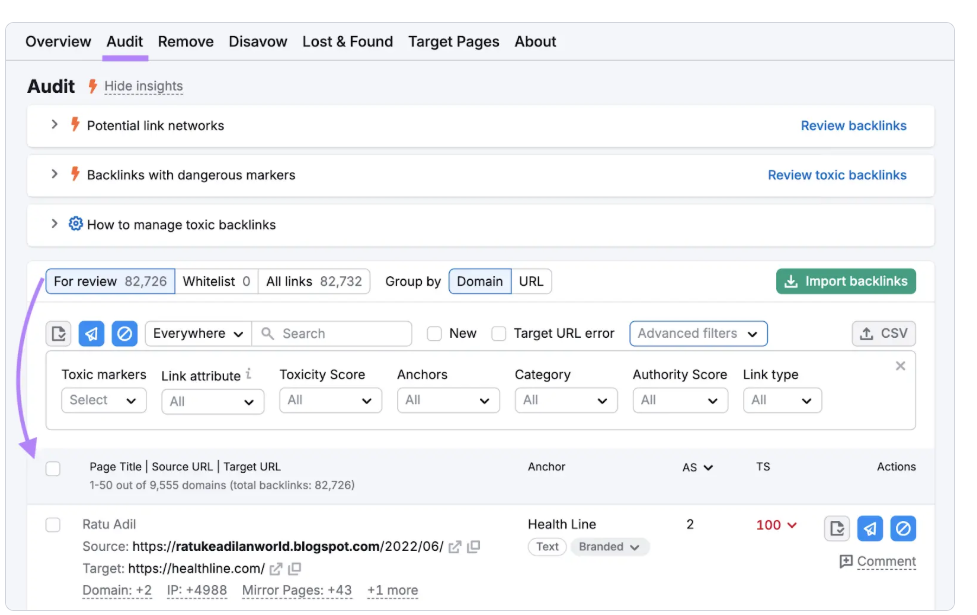
Create valuable, original resources that are difficult for others to duplicate or improve, giving publishers a strong incentive to reference your website or direct their audience to it.
For example, Healthline offers a comprehensive, trustworthy article on how much water one should drink.
This piece is frequently cited in related content, such as an article by HuffPost:
It’s essential that your resources closely align with your brand because:
- They enhance your content’s credibility and increase the likelihood of earning backlinks
- They attract links from websites within your niche or industry
- They generate additional business advantages beyond just SEO
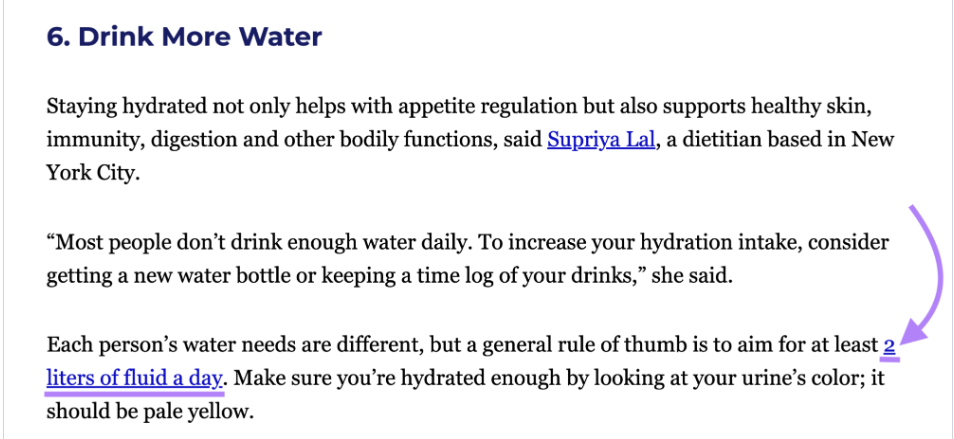
If you’re looking for ideas, analyze your competitors’ most linked pages by using tools like Backlink Analytics and exploring the “Indexed Pages” report.
This report reveals page titles, URLs, and key metrics such as the number of backlinks, referring domains, and internal and external links.
After crafting your content, reach out to high-quality sites that currently link to similar competitor pages. See if they’d be interested in linking to your more comprehensive or updated version instead.
Also, send outreach emails to other relevant publishers who might find your resource valuable.
Active promotion will help you gain more backlinks, and once you build momentum, you may start to attract natural links more easily.
2. Try Broken Link Building
Here’s your text improved with synonyms and a smooth, natural style without schema markup:
Broken link building involves identifying backlinks that no longer work—often because the target page has been removed—and offering a relevant link from your own website as a replacement.
This strategy is effective because website owners want to avoid having broken links on their pages, and you’re providing them with a simple fix.
To maximize your chances of success, focus on broken links that originally pointed to your site.
Start by checking the “Indexed Pages” report for your domain in Backlink Analytics.
Next, apply the “Broken Pages” filter to identify any non-functioning pages.
If you find a broken page, click the number in the “Backlinks” column to see details.
Evaluate which broken backlinks are worth recovering based on factors like the authority of the linking page and the relevance of the link’s context.
The report will show you useful metrics such as the number of backlinks, referring domains, anchor text, and the source page.
Finally, reach out via email to the appropriate website contacts to inform them about the broken link and suggest your replacement URL.
If you want, I can help you draft outreach email templates tailored specifically for broken link building!
3. Respond to Relevant Media Inquiries
Finding and answering relevant media requests is an excellent strategy for building backlinks because journalists and content creators often credit their contributors by linking to their websites.
For instance, a reporter might be looking for expert recommendations for a holiday gift guide or seeking professional insights on a particular topic.
An example would be an expert’s quote included within an article, with a link pointing to the expert’s organization or personal website.
You can find these media opportunities on platforms like Connectively, Qwoted, and Featured, which list requests along with details such as the question being asked, the source, and submission deadlines.
Here’s a simple process to get started:
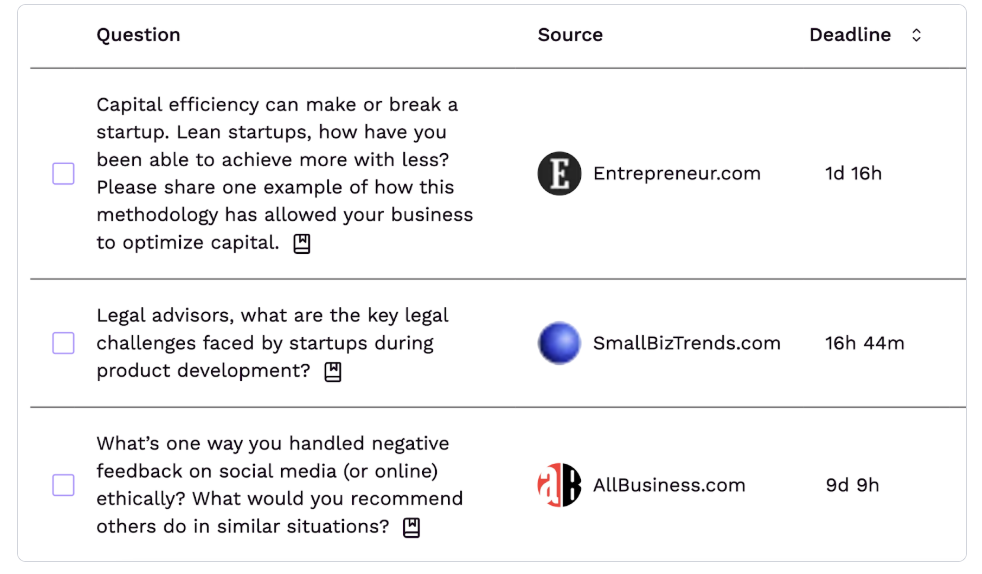
- Create an account on one or more relevant platforms and build a detailed profile showcasing your expertise
- Subscribe to alerts or notifications for media requests that align with your industry or interests, and regularly monitor your email for new opportunities
- Respond promptly and thoughtfully to relevant inquiries to increase your chances of being featured
The best platform for you will depend on your niche, geographic location, and the type of exposure you’re aiming for.
Not only does this method help you gain high-quality backlinks, but it also positions you as an authority in your field and can lead to valuable networking opportunities.
4. Replicate Your Competitors’ Backlinks
Replicating your competitors’ backlinks is one of the smartest and most powerful SEO strategies you can use – because it builds on proven tactics that deliver real results.
By identifying and acquiring the same high-quality links your rivals have secured, you can quickly close the competitive gap and gain a serious advantage in search rankings.
To get started, simply input your domain and up to four competitor domains into the Backlink Gap tool.
You’ll instantly discover the “Best” backlink opportunities-sites linking to all your competitors but not yet to you.
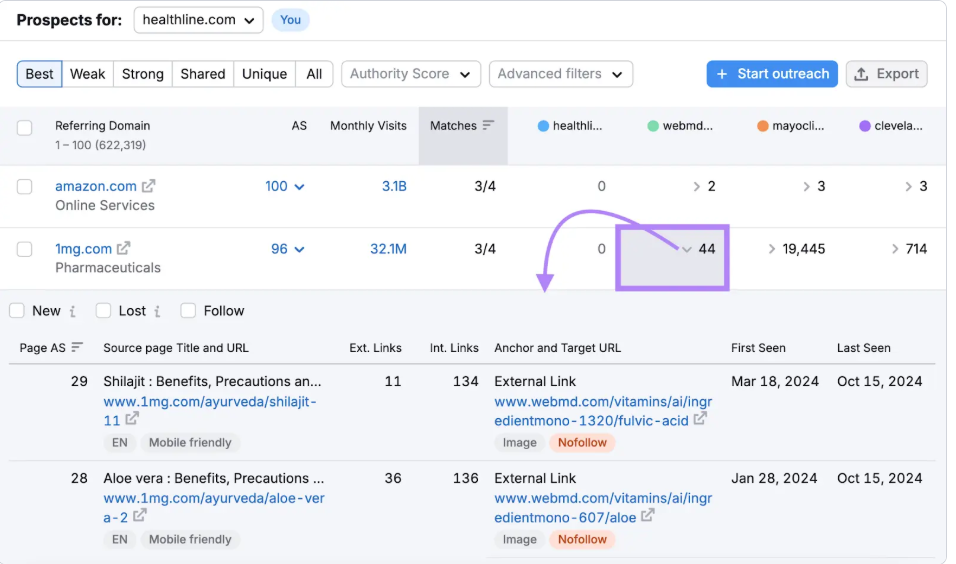
Explore these prospects by clicking through to see detailed information about each backlink, including the source page, link context, and other valuable metrics. This insight helps you decide which backlinks are realistic and valuable to pursue.
For instance, if your competitor’s CEO earned a backlink through an interview on a popular industry site, don’t hesitate to approach the same publisher with a compelling pitch to feature your CEO.
By strategically replicating these high-impact backlinks, you don’t just improve your SEO—you assert your presence, build authority, and position your brand as a formidable player in your market.
5. Capitalize on Business Relationships
Leverage every existing business relationship to secure valuable backlinks on external websites.
For example, you can build backlinks by:
- Providing detailed case studies to your service providers
- Offering authentic testimonials to freelancers or vendors
- Getting featured as a preferred partner on your distributors’ websites
- Announcing collaborative projects or initiatives on your partners’ blogs
- Securing listings on relevant trade association or industry websites
To begin, create a comprehensive list of all website owners and organizations your business is connected with. Then, carefully review their websites to identify natural opportunities for backlink placements.
Next, pinpoint the team members within your company who have the strongest rapport with each partner. Have them present the backlink idea personally to their contacts—this personalized approach significantly boosts your chances of success.
By strategically tapping into your existing network, you can quickly grow your backlink profile with trusted, relevant sources, strengthening your SEO and building your brand authority.
Keep Track of Your Link Building Efforts
Building backlinks for SEO can quickly become a complex and time-consuming challenge, especially when you’re juggling countless outreach efforts and tracking dozens of prospects.
That’s why Semrush’s Link Building Tool is a total game-changer. It simplifies every step of the process, so you can focus on what really matters — growing your site’s authority and driving meaningful results.
With this tool, you get everything you need in one powerful dashboard:
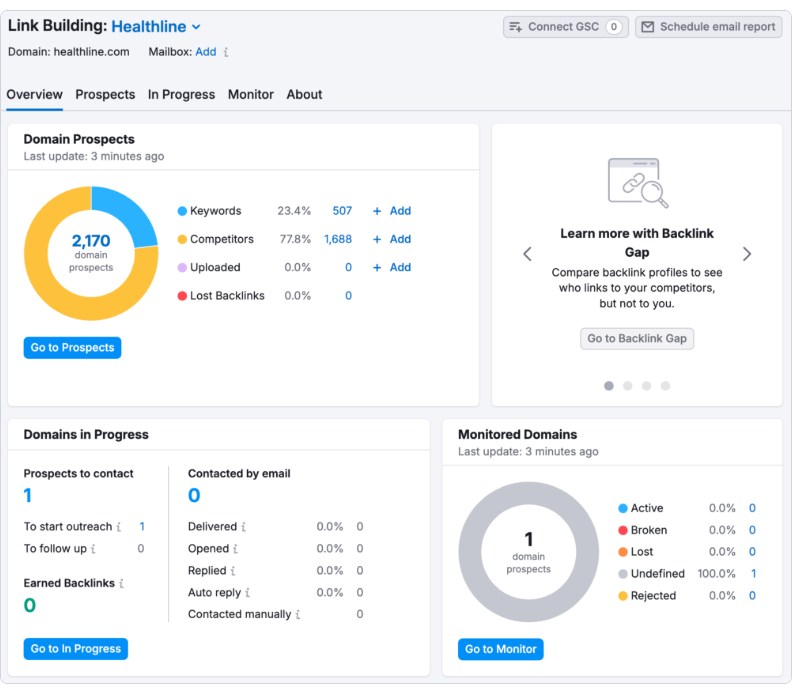
- A clear view of all your link-building opportunities, ranked by important metrics to help you prioritize where to focus your energy
- Real-time tracking of your outreach emails and responses, so you never miss a follow-up or lose track of a conversation
- An organized system to record every backlink you earn, giving you full control and confidence over your link profile
If you’re ready to take your SEO to the next level without the headache, sign up for a free Semrush account today and experience how much easier link building can be.
This tool doesn’t just save time — it empowers you to build authentic connections that truly boost your website’s success.
